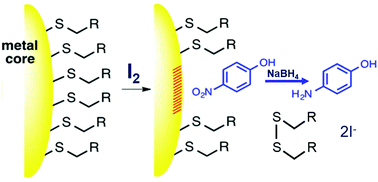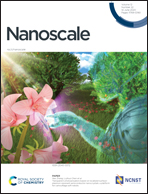Iodine activation: a general method for catalytic enhancement of thiolate monolayer-protected metal clusters†
Abstract
To enhance catalytic activity, the present study details a general approach for partial thiolate ligand removal from monolayer-protected clusters (MPCs) by straightforward in situ addition of iodine. Two model reactions are examined to illustrate the effects on the catalytic activity of glutathione (SG)-capped Au MPCs serving as a catalyst for the NaBH4 reduction of 4-nitrophenol to 4-aminophenol and SG-capped Pd MPCs serving as a catalyst for the hydrogenation/isomerization of allyl alcohol. Iodine addition promoted partial thiolate ligand removal from both MPCs and improved the catalytic properties, presumably due to greater surface exposure of the metal cores as a result of ligand dissociation. The rate of 4-nitrophenol reduction increased from 0.066 min−1 in the absence of I2 to 0.505 min−1 in the presence of 2.0 equivalents I2 (equivalents based on total ligated glutathione). The reaction of allyl alcohol to produce 1-propanol and propanal was similarly accelerated as indicated by the increase in turnover frequency from 131 to 230 moles products per moles catalyst per h by addition of 0.2 equivalents I2. In both reactions, as the amount of I2 added increases the catalyst recyclability decreases due to catalyst instability. Low equivalents of I2 are optimal when considering both reaction rate and catalyst recyclability.



 Please wait while we load your content...
Please wait while we load your content...
